







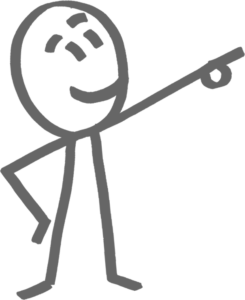

Graphic Recorder Strategic Visualiser, Award-winning Cartoonist, Writer and Animator.
I met Sarah Firth when I moved to Australia the second time in 2013. Sarah was for me THE graphic recorder, and I admired and still admire the great art she creates. Sarah is an award-winning comic artist, graphic recorder, writer and animator based in Melbourne.
In this fascinating episode of Visual Friends podcast, we learn about how she grew up in Canberra and later travelled the world. We hear about sketchnoting and how it helped Sarah focus at school. How she started her a career as an artist and how she got into graphic recording around 2010. She shares an incredible story about a major accident she’d been in and how sketchnoting helped her reconnect with her life while she was in the hospital.
Today, Sarah uses her skills in very challenging environments. She likes to work for non-for profit organisations, for example, helping people overcome trauma.
Sarah shares some tips about how you can improve your drawing skills over the years to become a rockstar in the field of graphic recording.
With that, please enjoy the episode and we look forward to welcoming you in person at VizConf on the 19th of October 2019 where we are privileged to have Sarah as one of our keynote speakers.
Sarah Firth is an award-winning comic artist and writer based in Melbourne. Since 2011, she has run a successful small business, offering graphic recording and facilitation, animation and event design. With the mission to help clients clarify, align, resolve, connect and communicate – through powerful visual modelling, storytelling and strategic mapping.
Sarah works across industries and sectors, with a particular interest in supporting clients navigating wicked problems, systemic change and high levels of complexity, environmental justice and social impact.
She has worked locally and internationally on projects and events with; Vienna Complexity Science Hub, Google, The Rockefeller Foundation, CSIRO, The Red Cross, Conservation Zoos Victoria, Melbourne Faculty of Business & Economics, Comedy Central, Environmental Justice Australia, SIEMENS, Vienna Complexity Science Hub, Not For Profit Law, ACMI, Aboriginal Victoria, KPMG, Pricewaterhouse Coopers, Planning Institute of Australia, Ernst & Young, City of Melbourne, Victorian Department of Premier and Cabinet, Oxfam, PLAN International and many more.
Alongside her business Sarah maintains a professional art and writing practice. Some notable achievements have been; receiving the Talking Difference Fellowship with the Immigration Museum, being named one of Australia’s top 25 artists by Art & Australia Magazine, winning The People’s Choice Award in the Australian Shorts section of the Human Rights Arts and Film Festival, performing at the Yogyakarta Biennale in Indonesia, the Lakes International Comic Festival in the UK, and the Ubud Writers and Readers Festival.
Most recently, she was appointed deputy chair on the board of directors for the Cultural Development Network, she received a Frankie Magazine Good Stuff Award, was a finalist in the Incinerator Social Change Art Award, and her graphic essay on complexity was listed in The Conversation’s ten best literary comics in Australia.
Sarah has a new illustrated book Badass Mums out now with Affirm Press, along with comics in upcoming publications with Allen & Unwin, Abrams Books and Picador Australia. She is currently working on her debut graphic novel thanks to the support of the Creators Fund.
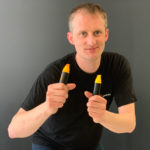
Marcel combines agile team coaching with visual thinking. Marcel believes that a group of people drawing together on a whiteboard can change the world. He loves high-performing teams and therefore coaches teams every day.
Antonio Meza is born in Mexico and has been drawing and sketching his whole life. He started his career as a cartoonist animating stick figures between 2 keyframes across the screen. He moved to Paris where he studied communication science and became a trainer and coach for neurolinguistic programming (NLP).
In the first part, Antonio introduces you into NLP and the science behind language patterns, body language and our eye movements. We clarify misunderstandings about NLP and talk about coaching contracts and the right coaching setting in general.
Antonio experience in coaching made him the perfect match to illustrate a book about success factor modelling which turned into the illustration of three books around the subject.
We talk about graphic recording using digital tools like iPad and ask the million-dollar question about his favourite iPad app for graphic recording on an iPad.
From here we give an introduction into symbolic thinking which we have decided to split the podcast into an extra episode about symbolic thinking.

Marcel combines agile team coaching with visual thinking. Marcel believes that a group of people drawing together on a whiteboard can change the world. He loves high-performing teams and therefore coaches teams every day.

Today I have the honour to bring to you Natalie Nelson. Natalie is the principal at Ashburton primary school. Her school never received much money since the 1920’s and were therefore entitled for a redevelopment. Natalie’s school received a big cheque which enabled her to bring the school to the next level of education.
Natalie tells her story of how she started on a journey to transform the school to a place of future education. Her approach is quite different to many others. She calls it design from the inside out. I give you an example what that means: After coming up with key principles what school should be about, they asked the children to create their new future school. You will learn why Ashburton primary has floor to ceiling windows or different learning areas for different students.
We talk about what it means to grow up in our complex world of today. What skills the kids need to learn which (by the way) are far beyond reading, writing and maths. Kids today need to learn how to keep their energy level in balance, how they can relax their mind and how to deal with complex problems in general. Those skills become much more valuable in the future. Today’s schools focus on deep thinking techniques because it is necessary for real creative work. You can outsource the process of writing but you can’t outsource the creativity. Through that we talk about the three levels of thinking and how to get down to the core thinking where the creative magic happens.
I think we all can do something about the future of our kid’s in the way they learn and even further in the way we all work together in our modern world. The insights from Ashburton primary school are not limited to school education at all, they are applicable to the way we work together in our offices as well.
So while you listen to this podcast think about who else would be inspired by the story and pass the ball on so that more people get in contact with the future of education. I hope you enjoy this episode with Natalie Nelson, principle at Ashburton primary school.
Finally, if the interview inspired you to improve your own creativity and visual thinking skills then you are welcome to come around to one of the bikablo® trainings. If you are in Europe jump over on bikablo.com and when you are in Australia or New Zealand have a look in the training section of my website and check out the training program there. Next one is coming up in Sydney, Melbourne and Perth and depending on when you book there might still be an early bird available. So jump over onto the website and book your next career step as a visual leader. Thanks again for listening – See you next time.

Marcel combines agile team coaching with visual thinking. Marcel believes that a group of people drawing together on a whiteboard can change the world. He loves high-performing teams and therefore coaches teams every day.



Helping others is natural to us but asking for help is sometimes difficult to many. The reason behind lays in the way we grew up, how we were raised and not at last in a school system that was focused on competition and performance not on collaboration and creative thinking. However, todays challenges in business lay in the ability to solve complex problems together as a team and for me one of the most important steps to become a strong team is to overcome the fear of asking for help and embrace the fact that nobody is perfect. Through that asking for help becomes a personal strength. Remember todays problems are just too complex for one brain anyway.
In this insight episode I walk you through a scenario how you can offer help as a visual leader. You don’t have to be the subject matter expert – just a good listener with a pen using a whiteboard. Often it is enough that the person who has the problem steps out of the problem space for a moment and explains the challenge to someone else. I explain you my 8-steps to help him/her to unblock any problem solving. By following the 8-steps you have a chance to engage even more people of your team in the solution design and through that improve your team and company culture on the long run. These steps are not always strictly followed, they shall be a guide to get started as a visual leader on a whiteboard.
I hope you enjoy this episode! Please share it in your network if it is useful for you.

Marcel combines agile team coaching with visual thinking. Marcel believes that a group of people drawing together on a whiteboard can change the world. He loves high-performing teams and therefore coaches teams every day.


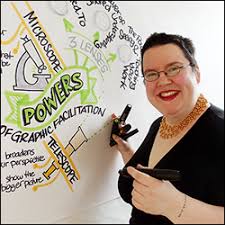
Founder Loosetooth.com
This episode is a great personal career story of Brandy Agerbeck from loosetooth.com. Brandy gives an insight into her career, including how she started as a knowledge worker with the MG Taylor model and how she went out on her own as a graphic facilitator a couple of years later.
She gives insights into her work including the Brandyfesto, Draw Quad and the process of writing her new book “The Idea Shapers“.
We talk about her TEDx Talk in Windy City in 2013 and chat about the future and where visualisation heading. If you would like to learn what a sneezy green person is then listen to this episode of Visual Friends Radio with Brandy Agerbeck from loosetooth.com.
If you are interested in meeting Brandy, please join her in her Winter or Sommer Lab in Chicago. A three day immersion where you will learn from Brandy firsthand.

Marcel combines agile team coaching with visual thinking. Marcel believes that a group of people drawing together on a whiteboard can change the world. He loves high-performing teams and therefore coaches teams every day.



Agile Coach, Visual Facilitator & Trainer Co-Founder Visual Friends
In the Visual Friends Radio Insights, I would like to share with you some experiences I have in my daily life working as an agile coach and visual facilitator. My name is Marcel van Hove and I hope you enjoy this episode called “The whiteboard dance”.
A couple of months ago I was working with two teams. One team was the front end and the other was the backend team. The backend team builds services that the frontend team would consume and build a beautiful user interface on top of it.
They were located on an open floor plan probably not more than 50 meters away from each other. Normally they would walk over to the other team if they had questions or need help.
One day things were a bit different. I noticed that when I walked past the frontend team they were a bit nervous and looked at me like they wanted to talk or needed help. I came closer and started chatting. It turned out that the new backend service didn’t behave as expected and even worse they were under pressure to release that day.
Because they were running on a tight schedule negative behaviour appeared that normally wouldn’t happen. The frontend team started blaming the other team for building a crappy API.
I walked over to the backend team to have a chat with them and explained what had just occurred to me.
As it turned out they already knew about the problem and had a clear answer for it. They didn’t agree that the problem lay in their API and it would behave as expected.
So here we are, the frontend team thinks they were provided with an API that does not meet their requirements while the backend team believe they have implemented a more than capable that has been integrated incorrectly.
At this point, you as the leader are at an intersection. One direction is labelled “The Blame Game” and the other direction is called “Road to Greatness”.
If you drive down the road of the blame game your teams will learn this behaviour and repeat it again and again. Long-term this behaviour destroys any company and makes it a miserable place to work.
I think most of us know that path. Things get escalated and you waste time in unproductive meetings where everyone tries to protect themselves. People act based on their reptile mind. If you’re strong enough you might attack – If you are weak you try to survive.
I ask you – independent of your role in your organisation – to step in and follow me on the “Road to Greatness”. I believe doing something great every day in a company will nurture the right behaviour and change the company’s culture in the long term for the better.
So let’s get back to our story. I said to the backend team, „Guys, We have two opposite understandings of the same services – We need to get together!” „Who can come around and help?“ I only asked for one or two people, but actually, the whole team stood up and walked with me over to the other team.
If you walk up somewhere with almost ten people you have an impact. They immediately stopped working and were surprised but happy that we took them seriously. I didn’t wait for an introduction and asked for attention:
I walked up to the whiteboard. Luckily, almost all the walls in the office are whiteboard walls so that we don’t need to drag someone into a meeting room.
Of course, I do a terrible job trying to explain the picture but often it is on you to get the first lines and boxes up on the wall. With that, you break the ice and set the right attitude and positive energy. People from both teams corrected my drawing and helped to finish the picture.
Let us pause here for a second. How is the situation now different to 15 minutes ago?
Before, we had two teams not talking to each other. Now we have two teams helping me draw the problem up on a whiteboard.
That is the beginning of a dance and this dance is about
• Pruning out any negative emotions by parking them on the wall.
• Keeping a positive attitude by focusing on the drawing.
• Creating a comprehensive picture on the wall so that people can ask each other questions.
• Preparing the team to take over again and passing the pen on to the teams.
• Creating options to solve the challenge.
It is a dance because no matter who steps on whose toes you keep on smiling and moving forward. You, as the person drawing, set small impulses that guide the group to draw the next line.
I start this dance as a neutral facilitator in front of the whiteboard by drawing the first lines and boxes. From here both teams help each other. It is like they would shake hands and agree to dance together. (Shaking hands is what I learnt to do before you dance with someone. At least when I went to classical dance school more than 20 years ago.)
Now, both teams throw great ideas at the whiteboard and create the picture on the wall to get “one shared understanding”. And whenever someone steps out of this agreement and steps on someone else’s toes you, as the visual facilitator says, „Thank you, let me park this here on the wall.“ But you don’t cut off, this would disengage them from the dance.
Back to the story and what happened next. We were standing in a half-circle in front of the board. We got the situation mapped out and very soon some people started creating ideas about what the reason for the misunderstanding could be. Then they grabbed their laptop, opened the screen and had a look at the data structure underneath and bang: They knew what the problem was. They solved it and released on the same day and by the way, at this point, they took over driver seat again and were in charge of the dance.
So why was this interruption and drawing together so important? I think the answer becomes obvious when you think about the options you have. You can either talk about the problem and document it and much later come to a meeting. But when you come to that meeting the problem has already become bigger then it actually is. The costs of delay have increased so that a lot of attention is on the topic. Additionally, you lost an opportunity to create a real connection between two awesome teams.
Most of the time, problems in IT are just little communication gaps that need to be closed. If you have this understanding stopping two teams from working and bringing them together is the right choice. Especially when you want to build an awesome company where people are not just good, they’re really great. They really rock the show and they build something awesome.
I hope you enjoyed this little insight into my world. And if you found it useful, please jump over on iTunes and subscribe. Give us a rating, share it with your friends, write us a comment that really helps us to get the word out and make more people aware of the bikablo drawing technique.
Additionally, if you think that person is really interesting and should be on the show or you have a request to talk about a topic – Please write me an email and I will get back to you.
I wish you a great rest of the week whichever office you draw on a whiteboard. If you think you can’t draw: I run monthly training in Australia, New Zealand and Live Online via Zoom. If you’re in Europe and listening to that there are monthly training in German-speaking Europe as well as in London and other cities. If you can’t find a bikablo visual facilitation training close to you, just write me an email!
Things to read from here:
• Stop the line principle explained by Eric Ries
• What visual facilitation is about?

Marcel combines agile team coaching with visual thinking. Marcel believes that a group of people drawing together on a whiteboard can change the world. He loves high-performing teams and therefore coaches teams every day.


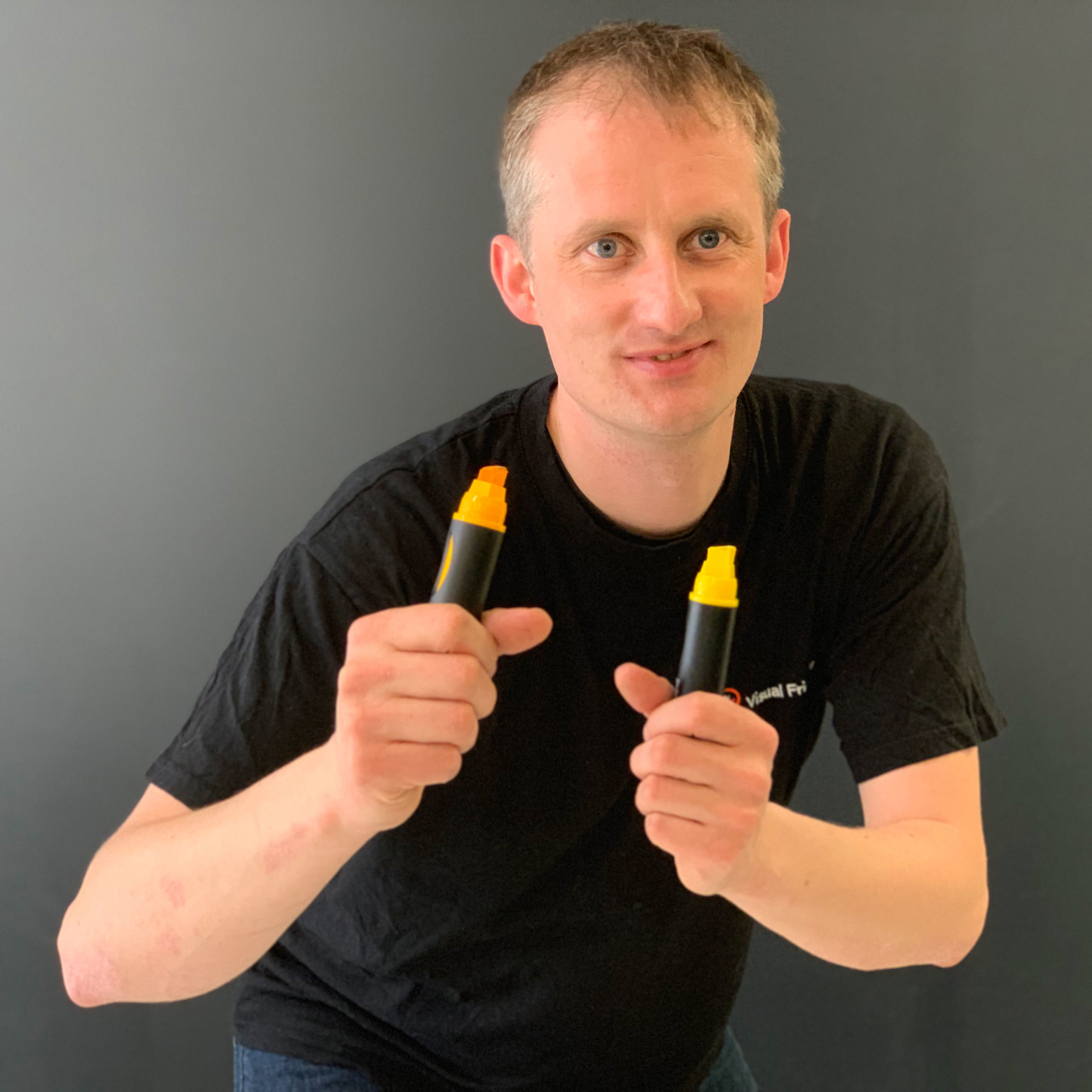
Trainer and Agile Coach
In everyday life, our brain processes picture all the time, for example when we see a car on the street. The brain will immediately connect it to all the information about how fast it is, which direction it is going and if it will be a threat or not. This is happening in pictures, not words and our brain processes visual information very effectively.
Drawing for yourself is a great way to create ideas and improve your memory. Most of us learn quicker if we visualise the content to be learnt. When recalling the information a picture comes up in your memory more easily than words.
Drawing also helps us to be creative. As my daughter said when asked why she would draw: “My brain creates new ideas”. That is absolutely right, drawing helps us to focus our mind and create new ideas. Or why do you doodle on the phone?
Drawing for your team is the next step. Brain science shows that about 25% of humans work mainly verbally. Another 30% work mainly visually and about 45% work best with both, words and pictures. So if you are addressing an audience you will only be able to reach 100% with a combination of words and pictures.
It is not about impressing the team with artistic masterpieces. Everyone can learn to communicate by drawing, there is no artistic talent required. It is about simple drawings that you use to explain what you mean.
Having to solve a problem? Drawing in meetings will start a conversation quicker. In the same way, as if you draw for yourself, you will create new ideas easily and you will identify more and more solutions. Having conflicts in a group? Draw the attention to the whiteboard and away from each other.
You become a leader of the conversation with a whiteboard marker. It brings a lot of focus and clarity into the discussion and helps to understand different points of view. The number of Aha! moments rises, people are much more engaged and it makes meetings much shorter and more effective.kingoroot app
If you have a complex problem to solve, I say you can probably save half of your meeting time just by drawing together. Take a photo of the whiteboard and every participant will be able to recall the meeting at one glance afterwards.
Think you can’t draw or a meeting on a whiteboard yet? We would like to invite you to come to our next bikablo® visual facilitation training and learn the simple drawing technique that so far more than 1000 people worldwide have learnt.

Marcel combines agile team coaching with visual thinking. Marcel believes that a group of people drawing together on a whiteboard can change the world. He loves high-performing teams and therefore coaches teams every day.

